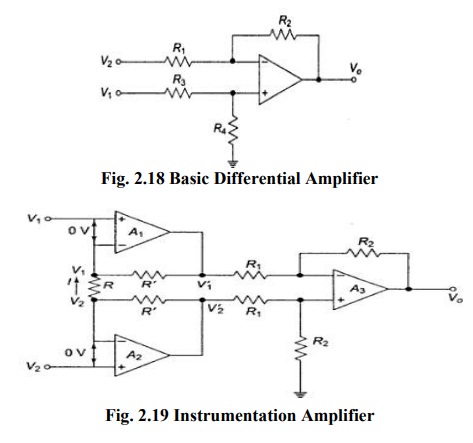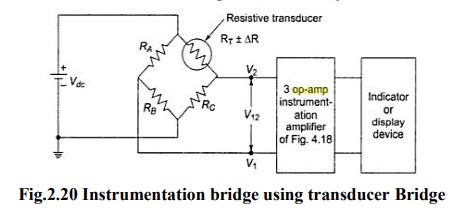Applications of Operational Amplifier - Instrumentation Amplifier using Operational Amplifier | Linear Integrated Circuits : Applications of Operational Amplifier
Chapter: Linear Integrated Circuits : Applications of Operational Amplifier
Instrumentation Amplifier using Operational Amplifier
Instrumentation
Amplifier:

Current
flowing in resistor R is I= ( V1-V2)/R and it flow
through R’ in the direction shown, Voltage at non-inverting terminal op-amp A3 is R2
V1’/(R1+R2). By superposition theorem,
Vo=
(R2/R1) V1+(1+R2/R1)(R2V2/(R1+R2)=R2/R1(
V1’-V2’);
V1’= R’I+ V1=R’/R( V1-V2)+
V1
V2’=
R’I+ V1=R’/R( V1-V2)+V2;
V0=
(R2/R1)[(2R’/R(V2- V1)+ (V2-
V1)] = (R2/R1)[(1+2R’/R)(V2- V1)
In
a number of industrial and consumer applications, one is required to measure
and control physical quantities.
Some
typical examples are measurement and control of temperature, humidity, light
intensity, water flow etc. these physical quantities are usually measured with
help of transducers.
The
output of transducer has to be amplified so that it can drive the indicator or
display system. This function is performed by an instrumentation amplifier. The
important features of an instrumentation amplifier are
1.
High
gain accuracy
2.
High
CMRR
3.
High
gain stability with low temperature coefficient
4.
Low
output impedance
There
are specially designed op-amps such as µA725 to meet the above stated
requirements of a good instrumentation amplifier. Monolithic (single chip)
instrumentation amplifier are also available commercially such as AD521, AD524,
AD620, AD624 by Analog Devices, LM363.XX (XX -->10,100,500) by National
Semiconductor and INA101, 104, 3626, 3629 by Burr Brown.
In
the circuit of figure 6(a), source V1
sees an input impedance = R3+R4 (=101K) and the impedance
seen by source V2 is only R1 (1K). This low impedance may
load the signal source heavily.
Therefore,
high resistance buffer is used preceding each input to avoid this loading
effect as shown in figure
The
op-amp A1 and A2 have differential input voltage as zero. For V1=V2, that is, under common
mode condition, the voltage across R will be zero. As no current flows through
R and R‘ the non-inverting amplifier.
A1
acts as voltage follower, so its output V2‘=V2. Similarly
op-amp A2 acts as voltage follower having output V1‘= V1. However, if V1≠V2, current flows in
R and R‘, and (V2‘- V1‘)> (V2- V1). Therefore, this circuit has
differential gain and CMRR more compared to the single op- amp circuit of
figure 2.10.
The
difference gain of this instrumentation amplifier R, however should never be made
zero, as this will make the gain infinity. To avoid such a situation, in a
practical circuit, a fixed resistance in series with a potentiometer is used in
place of R.
Figure
(c) shows a differential instrumentation amplifier using Transducer Bridge. The
circuit uses a resistive transducer whose resistance changes as a function of
the physical quantity to be measured.
The
bridge is initially balanced by a dc supply voltage Vdc so that V1=V2. As the physical
quantity changes, the resistance RT of the transducer also changes, causing an
unbalance in the bridge ( V1≠V2). This differential
voltage now gets amplified by the three op-amp differential instrumentation
amplifier.

RB(Vdc)/(RB+RA)=
RCVdc/(RC+RT)
Applications of instrumentation
amplifier with the transducer bridge,
o
temperature
indicator,
o
temperature
controller and
o light intensity meter .
Related Topics